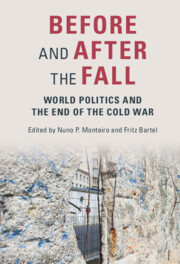Book contents
- Before and After the Fall
- Before and After the Fall
- Copyright page
- Dedication
- Epigraph
- Contents
- Figures
- Tables
- Contributors
- Preface
- Introduction
- Part I Sources of Continuity and Change
- Part II Continuity and Change Across the 1989/1991 Divide
- 6 The Nuclear Age
- 7 Legitimating Primacy After the Cold War
- 8 Russia’s Rejection of Liberal Politics
- 9 Continuity and Change in Russian Grand Strategy
- 10 The Stickiness of Strategy
- 11 Avoiding the Limelight
- Part III Toward a New World Order?
- Index
6 - The Nuclear Age
During and After the Cold War
from Part II - Continuity and Change Across the 1989/1991 Divide
Published online by Cambridge University Press: 02 December 2021
- Before and After the Fall
- Before and After the Fall
- Copyright page
- Dedication
- Epigraph
- Contents
- Figures
- Tables
- Contributors
- Preface
- Introduction
- Part I Sources of Continuity and Change
- Part II Continuity and Change Across the 1989/1991 Divide
- 6 The Nuclear Age
- 7 Legitimating Primacy After the Cold War
- 8 Russia’s Rejection of Liberal Politics
- 9 Continuity and Change in Russian Grand Strategy
- 10 The Stickiness of Strategy
- 11 Avoiding the Limelight
- Part III Toward a New World Order?
- Index
Summary
What Bernard Brodie said about nuclear weapons in 1946 continues to be true: The most important thing about nuclear weapons is that they exist and are terribly powerful. This was true in both the Cold War and the subsequent era. Although the situation has changed a great deal, there are striking continuities, especially in American attitudes and policies. Most obviously, the United States has consistently opposed nuclear proliferation, with only a very few exceptions for its closest friends. Second, the debate within the United States about the role of nuclear weapons has been altered only slightly by the end of the Cold War. The fundamental division between those who see nuclear weapons as having a revolutionary impact on world politics and those who do not continues. Trump’s Nuclear Posture Review makes arguments that are remarkably similar to those made under the Raegan administration. In parallel, the arguments made against Anti-Ballistic Missile (ABM) systems today are quite similar to those advanced during the Cold War, despite the radically changed conditions. This indicates that ways of thinking about nuclear weapons have become deeply engrained.
Keywords
- Type
- Chapter
- Information
- Before and After the FallWorld Politics and the End of the Cold War, pp. 115 - 131Publisher: Cambridge University PressPrint publication year: 2021

